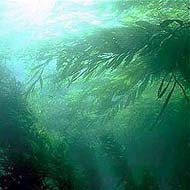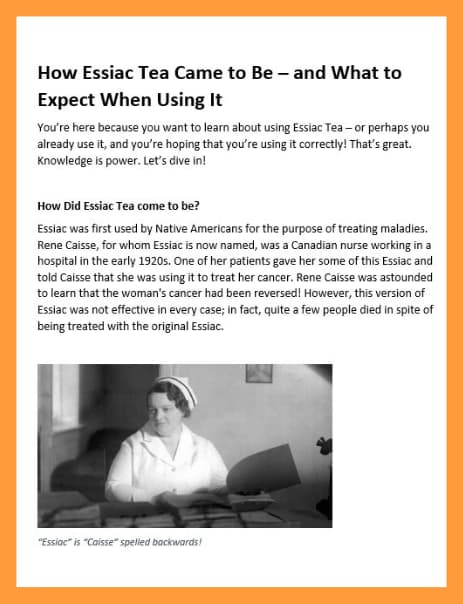- Home
- Nutrition Facts
- What is in Essiac
what is in essiac tea? Glad you asked.
essiac tea is comprised of 8 health-promoting herbs.
Wondering what is in essiac tea? Every product starts with the ingredients, and the 8 essiac tea ingredients are: blessed thistle, burdock root, kelp, red clover, sheep sorrel, slippery elm bark, turkish rhubarb root, and watercress.
The essiac tea ingredients need to be blended in a specific ratio for the herbal blend to be called "essiac." When blended in the correct ratio, the eight essiac tea ingredients have a more powerful effect than each of the herbs taken individually. The exact blend is proprietary. The formula provides a synergistic effect on health above and beyond the health-promoting benefits of each of the herbs when taken themselves. You can purchase eight herb essiac tea fully mixed and ready to use by clicking here.
Keep in mind too that Rene Caisse found that powdered herbs worked the best when she performed her research on essiac tea. Be sure you purchase powdered herbs when buying essiac tea.
***We use the entire sheep sorrel plant, including the roots, in our formula! It's 20% root. When looking at what is in essiac tea you may buy, be sure it contains the sheep sorrel including the root.***
Beware as well that there is an older version of essiac, called the four herb formula, and that formula is public knowledge. Many essiac tea companies sell only this type because they don't have the eight herb formula. They will market the older four herb essiac as "the original." While it's true that they have the original essiac, it's not the best essiac, and that is a very important distinction! Don't be fooled. You can see proof of our connection to the updated eight herb formula here.
We know that the eight herb formula is a more effective form of essiac, and therefore we only offer eight herb essiac on this website. The eight herb formula has a serving size of 3 oz. each serving. Four herb essiac carries a serving size of 2 oz. When you consume 8 herb essiac, you are consuming the same amount of the older four herb formula but then adding the additional four herbs that help enhance the effectiveness of the original four herbs. You're not missing out on anything at all!

Our formula was tested clinically at the Brusch Medical Research Center in Cambridge, MA. Dr. Charles Brusch worked with Rene Caisse to develop the ideal form of orally administered essiac, and the resulting eight herb formula is the same one that we carry on this website.
Keep reading to learn more about each of the eight herbs which make up the eight herb essiac formula. You'll learn about their beneficial properties and also their customary uses.
what is in essiac tea, exactly? learn more about the 8 essiac herbs

Blessed Thistle. Blessed thistle is used for digestive problems such as gas, constipation, and upset stomach. This herb is also used to treat liver and gallbladder diseases.

Burdock Root. Burdock root is a mild diuretic. It increases the production of both urine and sweat, potentially making it useful in treating swelling and fever. Burdock root might play a role in preventing liver damage caused by alcohol, chemicals, or medications. The exact reason for this protective effect is not known, but it is thought to involve opposition of a chemical process called oxidation, which occurs in the body as a natural function of metabolism. Although oxidation is a natural process, that doesn't mean it isn't harmful to the body in excess! One result of oxidation is the release of oxygen free radicals, which are chemicals that may suppress immune function. Antioxidants such as burdock may protect body cells from damage caused by oxidation.

Kelp. Kelp is a sea vegetable that is a concentrated source of minerals, including: iodine, potassium, magnesium, calcium, and iron. Kelp as a source of iodine assists in making the thyroid hormones, which are necessary for maintaining normal metabolism in all cells of the body. This increases energy levels and helps make it easier to maintain a healthy body weight. Kelp is the most nutrient-dense of all the essiac tea ingredients - and it isn't found in four herb formulas.

Red Clover. Red clover is a source of many valuable nutrients, including: calcium, chromium, magnesium, niacin, phosphorus, potassium, thiamine, and vitamin C. Red clover is also one of the richest sources of isoflavones. The isoflavones found in red clover have been studied for their effectiveness in treating some forms of cancer. It is thought that the isoflavones prevent the proliferation of cancer cells and that they may even destroy cancer cells.

Sheep Sorrel (including the root). Sheep sorrel is a rich source of oxalic acid, sodium, potassium, iron, manganese, phosphorous, beta carotene, and vitamin C. This essiac tea ingredient is a mild diuretic, mild antiseptic, and a mild laxative. Our blend contains the sheep sorrel root.

Slippery Elm Bark. Slippery elm bark has been used as a poultice for cuts and bruises, and also for aching joints due to gout or other causes. Besides being an essiac tea ingredient, this herb is also used on it's own to alleviate sore throats. Slippery elm bark is found in many lozenges that claim to soothe throat irritation. Since a sore throat and a cough are often linked, slippery elm bark has also been used in cough remedies. It also regulates the elimination process of digestion, easing both constipation and diarrhea.

Turkish Rhubarb Root. This detoxifying herb is world-famous for its healing properties. Rhubarb root purges the body of bile, parasites, and stagnating food in the gut by stimulating the gall duct to expel toxic waste matter. It has been shown to alleviate chronic liver problems by cleansing the liver. Rhubarb root improves digestion and helps regulate the appetite. It has also been shown to help heal ulcers, alleviate disorders of the spleen and colon, relieve constipation, and help heal hemorrhoids and bleeding in the upper digestive tract.

Watercress. Rich in Vitamin C, watercress is used as a general tonic, and its bitter taste is thought to regulate the appetite and improve digestion. It can be used to alleviate nervous conditions, constipation, and liver disorders. Watercress is a popular cough and bronchitis remedy. It contains a remarkable substance called rhein, which appears to inhibit the growth of pathogenic bacteria in the intestines. It is believed that rhein is also effective against Candida albicans (yeast infection), fever, inflammation, and pain. Watercress has a slighly bitter taste. If your essiac doesn't taste slightly bitter, it's a tip off that it's not real essiac! You can mask the taste with some stevia or all natural fruit/vegetable juice if you like.
nutrition facts and certificates of analysis
Check out the Nutrition Facts and our Certificates of Analysis for our essiac. By viewing these documents, you will be confident with what you are putting into your body on a daily basis.
order our most popular size of essiac tea today
Our Essiac takes just 10 minutes to make once every two weeks. It costs less than $1 per day to use.
Click here to order our most popular supply of Essiac tea! It will last six months at the Aggressive/Improvement of Health serving size and costs less than $1 per day to use.
If you'd rather start small, you can order 1 lb. of Essiac in four 4-oz. packets by clicking here. This order lasts two months at the Aggressive/Improvement of Health serving size, or three months at the Maintenance serving size. If you're not sure which serving size you need, click here to learn.
Disclaimer: Essiac is not FDA tested and has not been FDA approved as a treatment or cure for any health problem. We do not represent it as such on this site. You must determine whether essiac is a product you should pursue. We have provided accounts and descriptions that represent the opinions of a variety of experts as well as actual users of essiac. We believe that our formula is the best that money can buy. However, we do not endorse anything on this site as medical fact.




